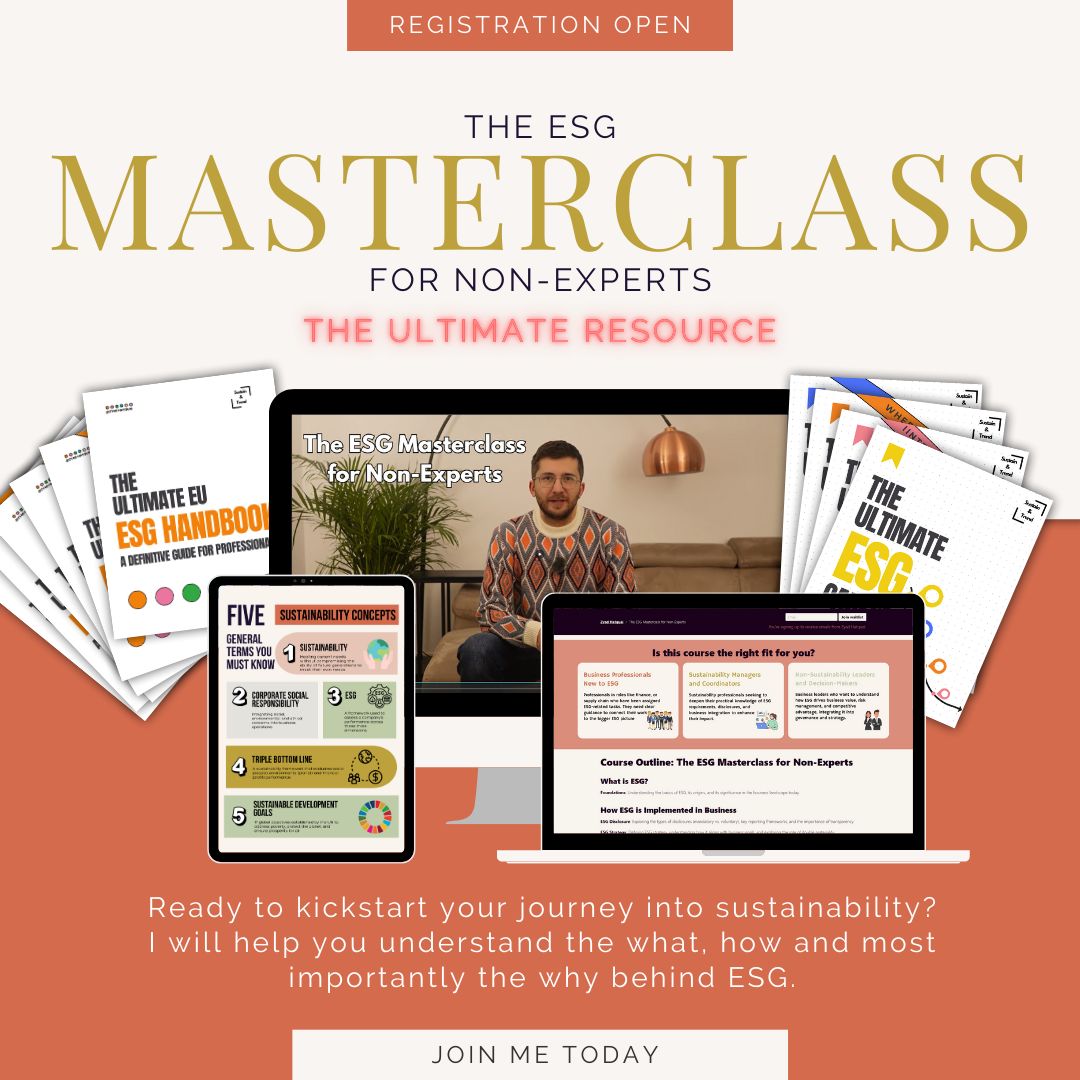The First Step to Success: Market Research—And Why ESG Needs the Same Approach
Imagine you’re launching a new product, expanding into a new market, or starting a business from scratch. What’s the very first step?
No one with a solid business background would tell you to just dive in blindly. You need market research. You need to validate your idea, assess the opportunity, understand the risks, and make sure you’re heading in the right direction. You don’t just act—you prioritize what matters, analyze stakeholders, and leverage existing data and frameworks before making big decisions.

Now, let’s shift this mindset to ESG and sustainability. Just like in business, you can’t build an effective sustainability strategy without first understanding what truly matters. That’s where double materiality assessment comes in.
It’s the ESG version of market research—a structured process to identify the most critical environmental, social, and financial issues impacting your company and its stakeholders. Yet, despite its importance, many companies are struggling to implement it effectively.
Why?
1. Treating Materiality Assessment as a Checkbox Exercise Before Reporting

Starting with the outcome in mind—as if materiality assessment is just a box to check for reporting—sets the stage for failure. This is exactly the mindset that sustainability teams must push back against.
Think of it this way: Imagine conducting market research only because someone told you to, but with zero intention of using the insights to shape your product, strategy, or market entry. You’ve already decided to launch, no matter what the research says. That’s a guaranteed way to fail.
The purpose of market research isn’t to tick a box—it’s to understand the market, assess risks and opportunities, and ensure your strategy is built on solid ground. Materiality assessment is no different.
Done right, it helps your business:
✅ Identify key risks and opportunities that could shape your ESG strategy.
✅ Pinpoint the most important environmental, social, and governance factors for your business and stakeholders.
✅ Ensure resources are focused on what truly matters—not just what looks good on paper.
If materiality is treated as a compliance task, it becomes an empty exercise. But when approached strategically, it guides real decision-making, ensuring sustainability initiatives drive real business impact—not just another page in a report.
Bottom line: Stop doing materiality for the sake of doing it. Start using it to prioritize what actually matters.
2. Scattered Data & Siloed Teams: The Biggest Barrier to Real Impact

Sustainability and ESG aren’t standalone topics—they touch every corner of your business.
Your operations impact the environment, your product or service affects customers and suppliers, and your entire value chain carries risks and opportunities that extend far beyond your own walls. Investors, too, factor in ESG risks when deciding whether to finance your company.
That’s why a real materiality assessment needs to include all these aspects—not just what the sustainability team thinks is important.
And here’s the key: The sustainability team isn’t the one with all the answers. They are facilitators, not sole decision-makers.
To get a meaningful outcome, companies must break silos and bring in:
✅ Finance – To align ESG risks with financial risks.
✅ Supply Chain & Procurement – To assess supplier-related impacts and risks.
✅ HR & Compliance – To ensure social and governance aspects aren’t overlooked.
✅Operations & Product Teams – To evaluate sustainability at the core of business activities.
The challenge? Collaboration is hard. Many teams see ESG as “someone else’s problem” and focus only on filling out templates without understanding why it matters. But with the right planning and clear communication, this process can become a powerful business tool rather than a frustrating paperwork exercise.
A well-organized double materiality assessment ensures that all voices are heard, risks are properly evaluated, and sustainability initiatives align with real business priorities—not just compliance checklists.
The solution? Break silos. Involve the right teams. Make ESG part of the business conversation.
3. Overcomplication & Analysis Paralysis: When Too Much Data Becomes a Problem

Many companies struggle with double materiality not because they lack data—but because they have too much and no clear plan to manage it.
Without proper organization and structure, companies fall into one of two traps:
❌ They overcomplicate the process—collecting excessive, unnecessary data that slows down decision-making.
❌ They freeze in analysis paralysis—unable to move forward because they’re overwhelmed by the sheer volume of information.
This is where consultants, advisors, and ESG SaaS providers must step up. Instead of making things more complex, they should be simplifying the process, helping companies:
✅ Follow a structured, standardized approach instead of reinventing the wheel.
✅ Streamline data collection and analysis so that materiality assessments remain efficient and actionable.
✅ Ensure clarity in prioritization—focusing on what matters most, rather than getting lost in endless data points.
Double materiality isn’t about collecting every possible ESG metric—it’s about identifying what’s truly material. When done right, it becomes a powerful strategic tool rather than a bureaucratic burden.
If your materiality assessment feels overwhelming, it’s a sign something is missing: a clear process, the right guidance, and a focus on what actually matters.
Here’s Why Over 4 Million Professionals Read Morning Brew
Business news explained in plain English
Straight facts, zero fluff, & plenty of puns
100% free
What is a Materiality Assessment? And Why Does It Matter?
At its core, a materiality assessment is a structured process that helps businesses identify and prioritize the most important ESG issues—both from a business perspective and a stakeholder perspective.
Single vs. Double Materiality: What's the Difference?
1️⃣ Single Materiality – Traditional financial materiality focuses only on how ESG issues impact the company’s financial performance. It answers questions like:

Will climate risks affect revenue?
Will supply chain disruptions increase costs?
Will new ESG regulations impact profitability?
2️⃣ Double Materiality – Goes beyond financial risks and considers both:

Impact Materiality → How does the company impact people, the environment, and society?
Financial Materiality → How do ESG factors financially impact the company?
The final outcome should be a prioritized list of material topics—but the challenge is striking the right balance.
How do you ensure nothing critical is overlooked, while also keeping the process streamlined and effective? How do you set yourself up for success, rather than getting lost in complexity?
1. Start Simple & Build Up
One of the biggest mistakes companies make with materiality assessments is trying to do everything at once—gathering excessive data, engaging too many stakeholders too soon, and overcomplicating the process before they even have a clear foundation.
Instead, the best approach is to start simple and build up.
✅ Begin with a high-level risk and impact mapping – Identify broad ESG topics relevant to your business before diving into granular details.
✅ Use existing frameworks – Leverage CSRD, GRI, ISSB, or other established standards to avoid reinventing the wheel.
✅ Prioritize efficiency over perfection – Materiality assessments are iterative; the first version doesn’t need to be exhaustive.
2. Engage the Right Stakeholders
A materiality assessment is only as strong as the perspectives it includes. Sustainability isn’t a one-team job—it cuts across finance, operations, procurement, HR, risk management, and beyond. The challenge? Many companies limit materiality to the sustainability team, missing critical insights from other key business functions.
To make your assessment accurate, strategic, and actionable, you need to engage the right stakeholders at the right time.
Who Should Be Involved?
✅ Finance & Risk Management – To align ESG with financial risks, investor expectations, and regulatory compliance.
✅ Operations & Supply Chain – To assess environmental and social risks related to sourcing, production, and logistics.
✅ Procurement – To evaluate supplier sustainability performance and mitigate risks in the value chain.
✅ HR & Compliance – To address governance, diversity, labor rights, and ethical business practices.
✅ Marketing & Communications – To ensure transparency in sustainability messaging and avoid greenwashing.
✅ Customers, Investors & External Stakeholders – To capture external expectations and emerging ESG trends.
3. Prioritize, Don’t Paralyze
One of the biggest pitfalls in materiality assessments is trying to do too much at once—engaging every stakeholder equally, collecting excessive data, and overcomplicating the process to the point of inaction. More data isn’t always better.
How to Avoid Overwhelm While Still Getting Quality Insights
✅ Segment Your Stakeholders – Instead of treating all stakeholders equally, identify which groups have the most influence or are most impacted by ESG topics. This helps streamline engagement without missing key insights.
✅ Layered Engagement Approach:
Broad & Simple Surveys → For general stakeholder groups (employees, customers, suppliers) to get high-level trends.
In-Depth Engagement → For key stakeholders (investors, senior executives, regulatory bodies, key customers, major suppliers) through interviews, workshops, or working groups to go deeper into critical insights.
Targeted Two-Way Conversations → With a small, prioritized group of high-impact stakeholders to validate and refine findings.
✅ Focus on Decision-Driving Data – Not all ESG topics are equally important. Prioritize data that directly impacts strategy, financial risk, and compliance rather than gathering every possible ESG metric.
✅ Refine & Iterate – Start with broad inputs, analyze the key patterns, and narrow the focus to the most material topics before deep diving. This avoids analysis paralysis and ensures the assessment leads to clear, actionable priorities.
Ready to Lead ESG with Confidence?
If you want to develop a strategic understanding of ESG, learn how to apply it to real business challenges, and ensure you have the right skills to drive ESG initiatives, check out the ESG Masterclass.
This program is designed to help you:
✅ Understand ESG beyond compliance – Learn how sustainability drives business value.
✅ Navigate ESG frameworks & regulations – Gain clarity on CSRD, ESRS, GRI, ISSB, and more.
✅ Establish yourself as a leader in ESG – Equip yourself with the tools to influence decision-making and implement effective strategies.

Take the next step in becoming a strategic ESG leader—one who drives impact, not just reporting. 🚀
If you are enjoying this content don’t forget to follow me on LinkedIn for more updates and insights.
Also subscribe to my YouTube channel for upcoming content—stay tuned for exciting videos! Once we hit 500 subscribers, I'll start transforming all the content into engaging video format. Stay tuned!
Seeking impartial news? Meet 1440.
Every day, 3.5 million readers turn to 1440 for their factual news. We sift through 100+ sources to bring you a complete summary of politics, global events, business, and culture, all in a brief 5-minute email. Enjoy an impartial news experience.



